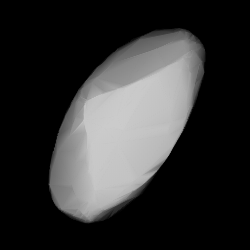|
2839 Annette
2839 Annette (prov. designation: 1929 TP) is a bright Flora asteroid from the inner regions of the asteroid belt. It was discovered on 5 October 1929, by American astronomer Clyde Tombaugh at Lowell Observatory during his search for Pluto.[9] The presumed S-type asteroid has a rotation period of 10.5 hours and measures approximately 5 kilometers (3.1 miles) in diameter. It was named after the discoverer's daughter.[2] Orbit and classificationAnnette is a S-type asteroid and member of the Flora family, one of the largest families of stony asteroids. It orbits the Sun in the inner main-belt at a distance of 1.9–2.5 AU once every 3 years and 4 months (1,205 days). Its orbit has an eccentricity of 0.15 and an inclination of 5° with respect to the ecliptic.[1] Due to a precovery taken at Lowell Observatory, the body's observation arc was extended by 4 days prior to its official discovery observation.[9] NamingThis minor planet was named after Clyde Tombaugh's daughter, Annette.[2] The approved naming citation was published by the Minor Planet Center on 22 June 1986 (M.P.C. 10845).[10] Physical characteristicsRotation period The first rotational lightcurve of Annette was obtained by American astronomer Brian Warner at his Palmer Divide Observatory, Colorado, in December 2005. It gave a rotation period of 10.457 hours with a brightness variation of 0.92 magnitude (U=3-).[7] In November 2006, a second lightcurve by astronomer Robert Buchheim at Altimira Observatory in southern California gave a concurring period of 10.4595 hours and an amplitude of 0.64 magnitude (U=3). He also noted a significantly fainter absolute magnitude of 14.35 than previously reported.[8] Diameter and albedoAccording to the survey carried out by NASA's Wide-field Infrared Survey Explorer with its subsequent NEOWISE mission, Annette measures between 5.41 and 7.562 kilometers in diameter and its surface has an albedo between 0.056 and 0.47,[4][5][6] while the Collaborative Asteroid Lightcurve Link assumes an albedo of 0.24 – derived from 8 Flora, the largest member and namesake of its family – and calculates a diameter of 3.66 kilometers using Robert Buchheim's fainter absolute magnitude of 14.35.[3] References
External links
|
||||||||||||||||||||||||||||||||||||||||||||||||||||||||||||||
